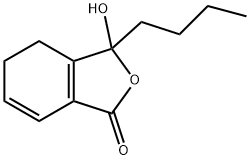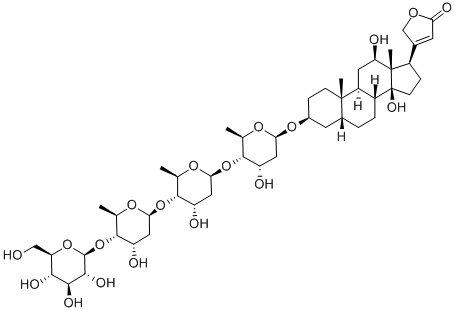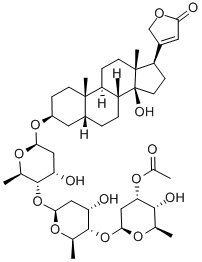A3378012
Digitoxin , ≥92%(HPLC) , 71-63-6
Synonym(s):
;Digitoxin;Digitoxoside;Lanatoxin
CAS NO.:71-63-6
Empirical Formula: C41H64O13
Molecular Weight: 764.94
MDL number: MFCD00003686
EINECS: 200-760-5
| Pack Size | Price | Stock | Quantity |
| 5mg | RMB79.20 | In Stock |
|
| 25mg | RMB151.20 | In Stock |
|
| 50MG | RMB239.20 | In Stock |
|
| 250MG | RMB839.20 | In Stock |
|
| 1G | RMB2652.00 | In Stock |
|
| others | Enquire |
Update time: 2022-07-08
PRODUCT Properties
| Melting point: | 240 °C (dec.)(lit.) |
| alpha | D20 +4.8° (c = 1.2 in dioxane) |
| Boiling point: | 654.47°C (rough estimate) |
| Density | 1.0971 (rough estimate) |
| refractive index | 17 ° (C=2, CHCl3) |
| Flash point: | 9℃ |
| storage temp. | 2-8°C |
| solubility | chloroform: soluble |
| form | powder |
| pka | 13.50±0.70(Predicted) |
| color | White |
| Water Solubility | 3.9mg/L(25 ºC) |
| Merck | 14,3163 |
| BRN | 76678 |
| Stability: | Hygroscopic |
| EPA Substance Registry System | Digitoxin (71-63-6) |
Description and Uses
Digitoxin is the most powerful and reliable of the glucosides which have been extracted from digitalis leave. It is a cardiac glycoside (CG). It is a cardiotonic drug, which exhibits cardiac and anti-cancer properties. Digitoxin inhibits nuclear factor kappa B (NF-κB) signaling. It is used to treat congestive heart failure and cardiac arrhythmia. Digitoxin prevents microtubule formation.
Digitoxin is used for chronic cardiac insufficiency, tachyarrhythmia form of atrial fibrillation, paroxysmal ciliary arrhythmia, and paroxysmal supraventricular tachycaria.
Safety
| Symbol(GHS) |   GHS06,GHS08 |
| Signal word | Danger |
| Hazard statements | H300-H331-H373 |
| Precautionary statements | P260-P264-P270-P301+P310-P304+P340+P311-P314 |
| Hazard Codes | T,F |
| Risk Statements | 23/25-33-39/23/24/25-23/24/25-11 |
| Safety Statements | 45-36/37-16 |
| RIDADR | UN 2811 6.1/PG 1 |
| WGK Germany | 3 |
| RTECS | IH2275000 |
| F | 3-10 |
| TSCA | Yes |
| HazardClass | 6.1(a) |
| PackingGroup | II |
| HS Code | 2938900000 |
| Hazardous Substances Data | 71-63-6(Hazardous Substances Data) |
| Toxicity | LD50 in guinea pigs, cats (mg/kg): 60.0, 0.18 orally (Foerster) |






